
The sand martin or European sand martin, bank swallow, and collared sand martin in India, is a migratory passerine bird in the swallow family. It has a wide range in summer, embracing practically the whole of Europe and the Mediterranean countries and across the Palearctic to the Pacific Ocean. It is a Holarctic species also found in North America. It winters in eastern and southern Africa, South America, and the Indian Subcontinent.

Vitis riparia Michx, with common names riverbank grape or frost grape, is a vine indigenous to North America. As a climbing or trailing vine, it is widely distributed across central and eastern Canada and the central and northeastern parts of the United States, from Quebec to Texas, and eastern Montana to Nova Scotia. There are reports of isolated populations in the northwestern USA, but these are probably naturalized. It is long-lived and capable of reaching into the upper canopy of the tallest trees. It produces dark fruit that are appealing to both birds and people, and has been used extensively in commercial viticulture as grafted rootstock and in hybrid grape breeding programs.

Dwarf sheet spiders (Hahniidae) is a family of araneomorph spiders, first described by Philipp Bertkau in 1878. Their bodies are about 2 millimetres (0.079 in) long, and they build extremely delicate webs in the form of a sheet. Unlike many spiders the web does not lead to a retreat. The silk used in these webs is so fine that they are difficult to spot unless they are coated with dew. They greatly favor locations near water or near moss, and are often found in leaf litter and detritus or on the leaves of shrubs and trees.
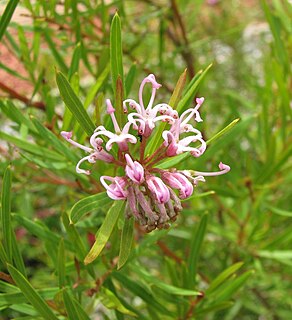
Grevillea sericea, commonly known as the pink spider flower, is a shrub endemic to New South Wales, Australia.
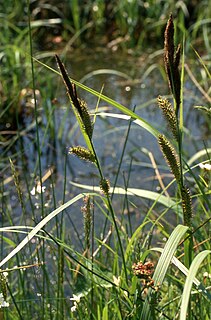
Carex riparia, the greater pond sedge, is a species of sedge found across Europe and Asia. It grows in a variety of wet habitats, and can be a dominant species in some swamps. It is Britain's largest Carex, growing up to 130 cm tall, with glaucous leaves up to 160 cm long. It hybridises with a number of other Carex species, including the closely related Carex acutiformis – the lesser pond sedge. A variegated cultivar is grown as an ornamental grass.
Hollandaea riparia, sometimes named roaring Meg hollandaea, is a species of Australian rainforest small trees, in the plant family Proteaceae.
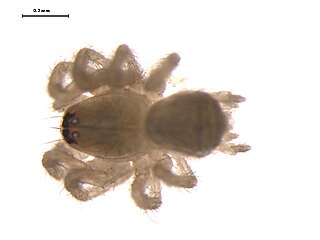
Neoantistea is a genus of dwarf sheet spiders that was first described by Willis J. Gertsch in 1934.
Clubiona riparia, the riparian sac spider, is a species of sac spider in the family Clubionidae. It is found in Russia, Mongolia, China, Japan, and North America.
Clubiona kastoni, the kaston sac spider, is a species of sac spider in the family Clubionidae. It is found in the United States and Canada.

Trachelas tranquillus, the broad-faced sac spider, is a species of true spider in the family Trachelidae. It is found in the United States and Canada.

Abagrotis baueri is a species of cutworm or dart moth in the family Noctuidae. It is found in North America.

Philodromus marxi, the metallic crab spider, is a species of running crab spider in the family Philodromidae. It is found in the United States.
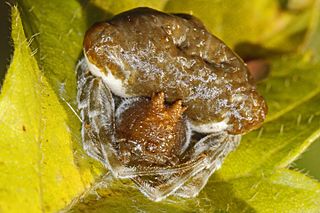
Mastophora phrynosoma is a species of orb weaver in the spider family Araneidae. It is found in the United States. Like all known species of the genus Mastophora, adult females are bolas spiders, capturing their prey with one or more sticky drops at the end of a single line of silk rather than in a web. Males and juvenile females capture their prey directly with their legs.
Pocadicnemis pumila is a species of dwarf spider in the family Linyphiidae. It is found in North America, Europe, Turkey, Caucasus, a range from Russia, and Japan.

Neoantistea magna is a species of true spider in the family Hahniidae. It is found in the United States and Canada.
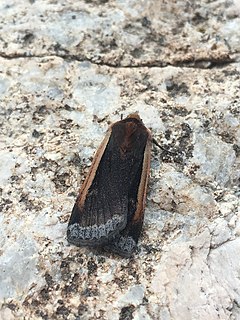
Abagrotis bimarginalis is a species of cutworm or dart moth in the family Noctuidae. It is found in Central America and North America.

Scytodes fusca, the brown spitting spider, is a species of spitting spider in the family Scytodidae. It is found in Central and Southern America, has been introduced into Europe, tropical Africa, Seychelles, Myanmar, China, Japan, and Hawaii.
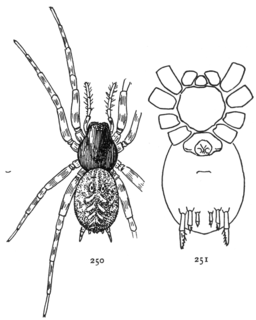
Neoantistea agilis is a species of true spider in the family Hahniidae. It is found in the United States and Canada.













